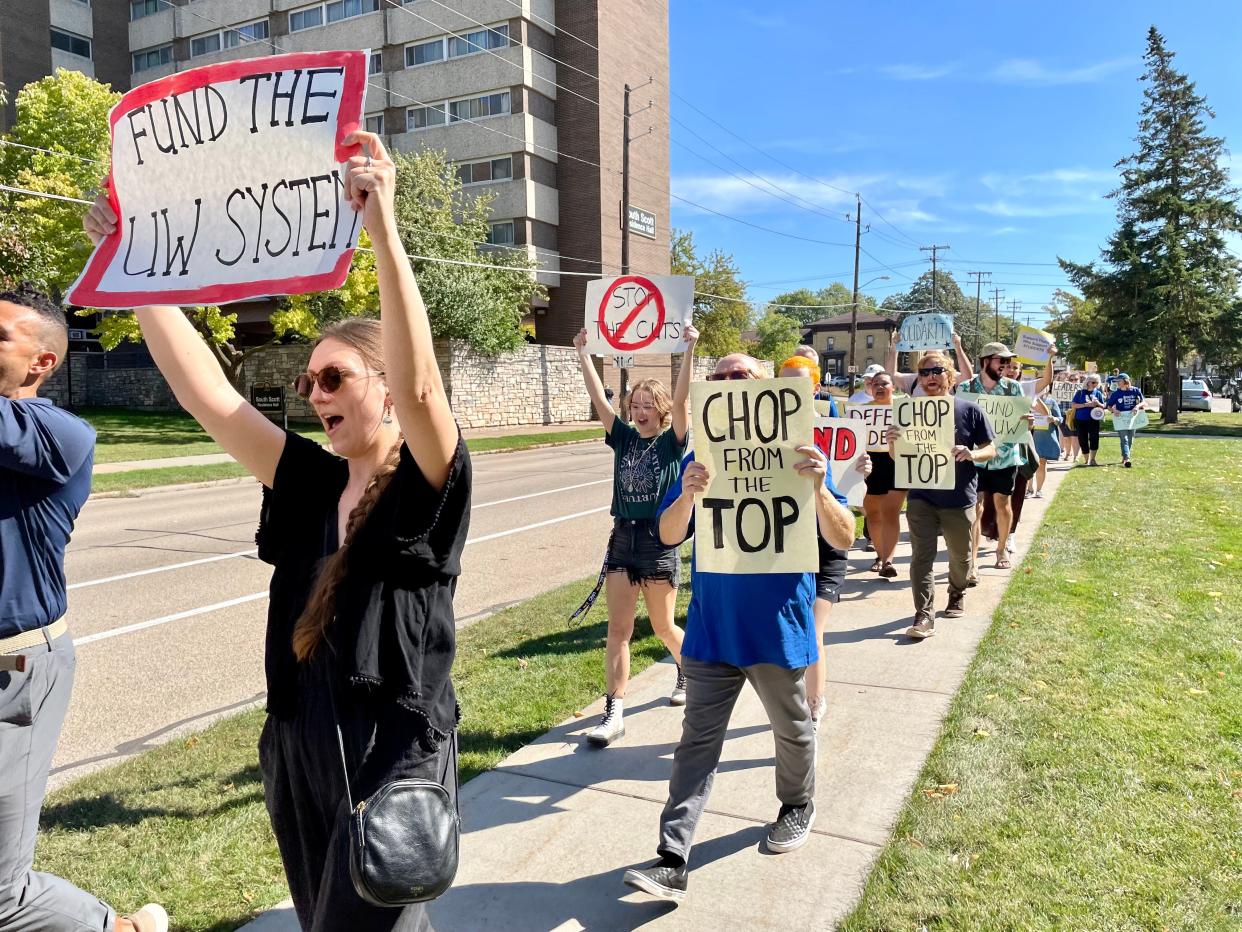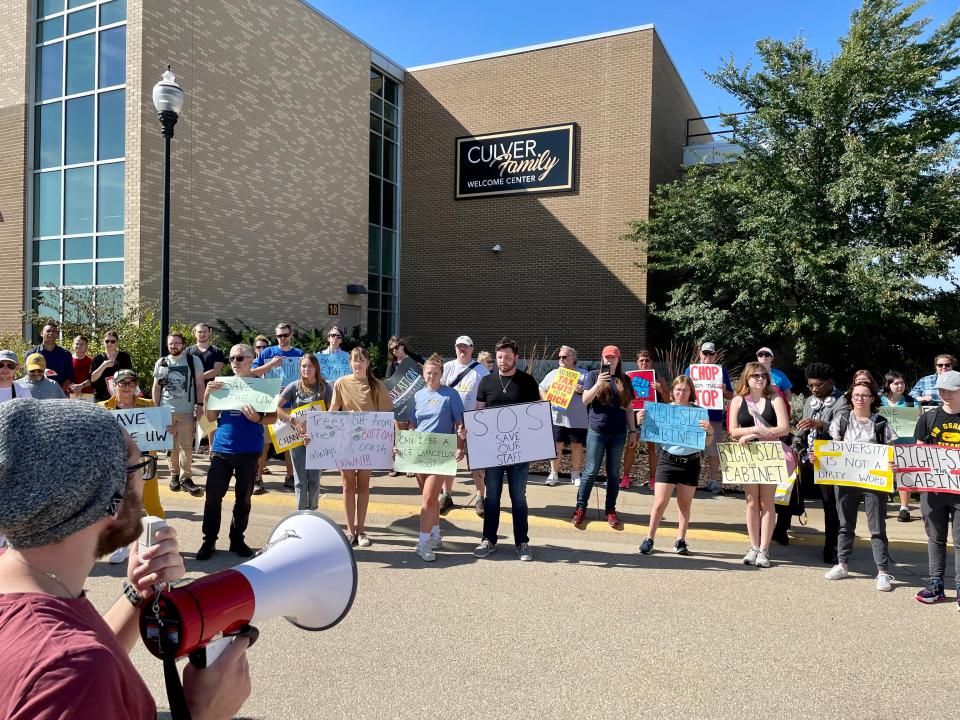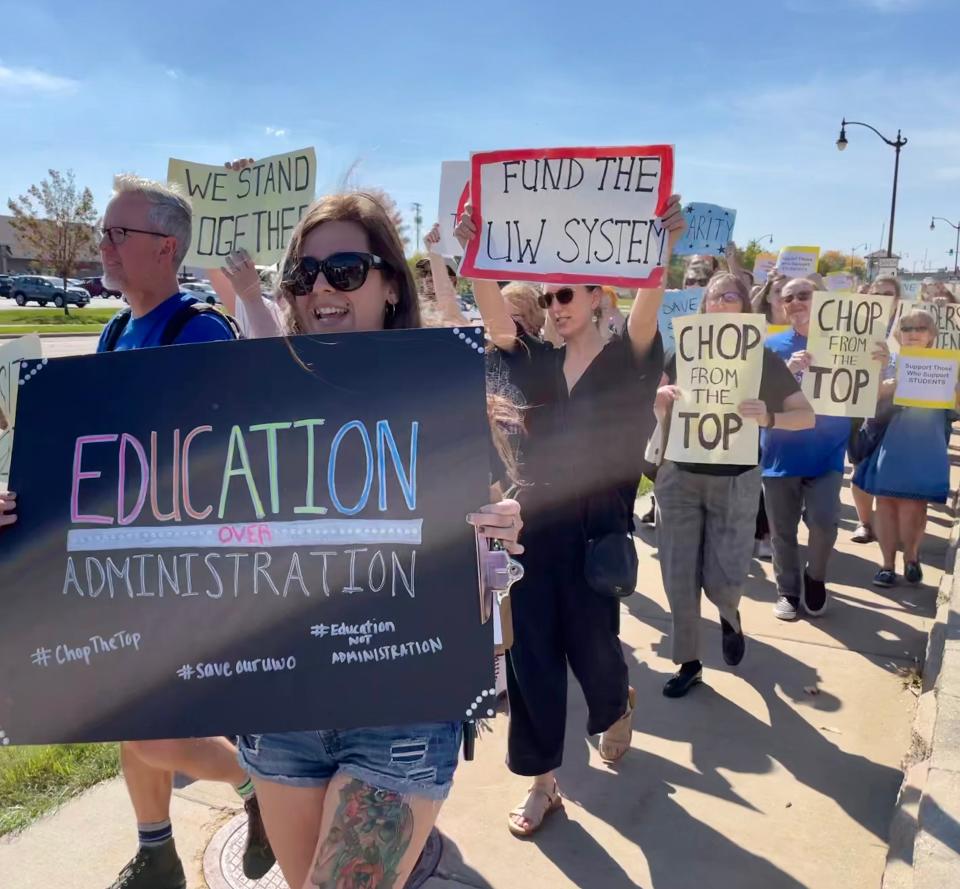Layoffs, furloughs, increased workloads fuel protest at UW-Oshkosh

OSHKOSH − Chants of "Save our staff!" and "Education over administration!" echoed across the University of Wisconsin-Oshkosh on Tuesday as protesters took aim at campus plans to eliminate more than 200 jobs.
Layoff notices are expected to go out the week of Oct. 16. At least 200 of the roughly 1,400 UW-Oshkosh employees will lose their jobs to help close a nearly $18 million budget shortfall.
But faculty said the cuts may actually go much deeper. With the university asking for voluntary retirements and some lecturers already receiving notice of contract nonrenewals, several professors said the number of lost jobs could be closer to 300.
Protesters focused their frustration at Chancellor Andrew Leavitt and other top administrators.
"If I were as irresponsible with my department budget as this administration has been with the university's budget then I wouldn't have a job today," Cindy Schultz, a 40-year university employee who handles administrative work for an academic department, told a crowd of about 100 protesters. "It's time to chop from the top."
Leavitt has emphasized the need to protect the teaching and learning missions of UW-Oshkosh. That's why faculty are shielded from this round of cuts. Other staff are holding their breath and bracing for the worst.
"October will be a difficult month at UW Oshkosh," he wrote in an email last week to the campus community. "There is nothing I can say to ease this process or the impact it will have on colleagues who lose their positions."
For sociology professor Paul Van Auken, morale feels the lowest it's been in his 16 years on campus. He said the closest comparison came in 2011 when UW System workers lost their right to collectively bargain. But even then, the situation felt better. The public was aware. He believes that isn't the case now.
"This is more like slow starvation of the UW System," he said. "We're facing a crisis based on decisions made partly by administrators here. I think this is under the radar for how dramatic these changes are going to be."
UW-Oshkosh students weigh in on budget cuts
UW-Oshkosh senior Sarah Kleinschmidt is already seeing the effects of the budget cuts, which go beyond layoffs. Faculty workloads are increasing and campuswide furloughs essentially cut existing employees' pay.
In addition to her environmental studies and geology double major, Kleinschmidt is pursuing a certificate in geographic information science. A reduction in the certificate's class offerings forced her to take an independent study, she said. But the professor who agreed to oversee her recently backed out, citing too many other work demands.
"I don't blame them for this at all," Kleinschmidt said. "I, too, would refuse work for less than I deserve, let alone for free."
Kleinschmidt is scheduled to graduate in December — without the GIS certificate she had wanted.

UW-Oshkosh senior Megan Kitzman, of Appleton, said most students aren't yet aware of the cuts. She heard about it only through her friends who write for the Advance-Titan, the student newspaper. She worries the opportunities she's had on campus will disappear for future students.
"I wish staff would talk about it more," said Kitzman, who is majoring in radio, television and film. "But they're so scared. And I get why, but without them, we can't get an education."
UW-Oshkosh finances were strong just two years ago
The situation facing the state's third largest public university this fall is a far cry from how UW-Oshkosh portrayed its financial state just two years ago.
In an October 2021 presentation to the UW Board of Regents titled "From the Red to Green," then-chief financial officer James Fletcher said the university was "standing in a positive financial position" and establishing a financial reserve.
UW-Oshkosh spokesperson Alex Hummel said the presentation was "a moment of pride" after several years of cost-cutting and accurately reflected a strong financial position at that time.
"Unfortunately, that stability was short lived," he said. "Furloughs and federal relief funds helped UWO and most institutions through the COVID-19 pandemic. However, enrollment declines persisted. Costs increased due to inflation. That perfect storm accelerated the depletion of reserves in subsequent fiscal years."

Enrollment has fallen 13%, or roughly 2,000 students, since 2019, according to UW System data.
UW-Oshkosh had the lowest financial health ranking among Wisconsin's 13 public universities in the 2022 fiscal year. It scored 0.2 on a financial ratio that takes into account several measures, such as debt management and net operating revenue.
The university's accrediting body considers a ratio of 1.1 or higher to be indicative of good financial health.
UW-Oshkosh has failed to meet the 1.1 threshold in six of the last seven years. Every other school within the UW System scored above 1.1 in 2022.
Does UW-Oshkosh have too many administrators?
Among the signs protesters held as they wound their way through campus Tuesday: "Right-size the cabinet" and "Trees cut from the bottom always crash down" and "Clean out the cabinet" and "Love it or Leavitt."
At the heart of their anger is a belief that there are simply too many people with titles like "vice chancellor" and "assistant vice chancellor and "associate vice chancellor" drawing salaries far heftier than the average worker.
The number of UW-Oshkosh administrators and academic leaders increased from 72 in 2013 to 122 a decade later, according to UW System data. The 69% increase was the third largest across the UW System, just behind UW-Madison and UW-Green Bay, both of which have seen student enrollment grow instead of decline.
Part of what drove the increase in administrative numbers was a UW System restructuring that put UW-Fox Cities and UW-Fond du Lac under UW-Oshkosh oversight in 2018, Hummel said. A UW System-wide project recategorizing employee titles in 2021-22 also helped explain the administrative growth.
Hummel pointed to a different data point, administrative spending as a percentage of total spending, which shows UW-Oshkosh tied for the second lowest at 8%. She said enrollment decline and rising costs continue to be the greatest pressures on the university's finances.
Administrators later this month will share their layoff plan, which will include a breakdown of the cuts by job classification and division.
In a letter to Faculty Senate President Pascale Manning, Leavitt confirmed senior level staff and administrative positions will need to go to close the deficit.
Contact Kelly Meyerhofer at kmeyerhofer@gannett.com. Follow her on Twitter at @KellyMeyerhofer.
This article originally appeared on Milwaukee Journal Sentinel: UW-Oshkosh students and staff protest layoffs, budget cuts

